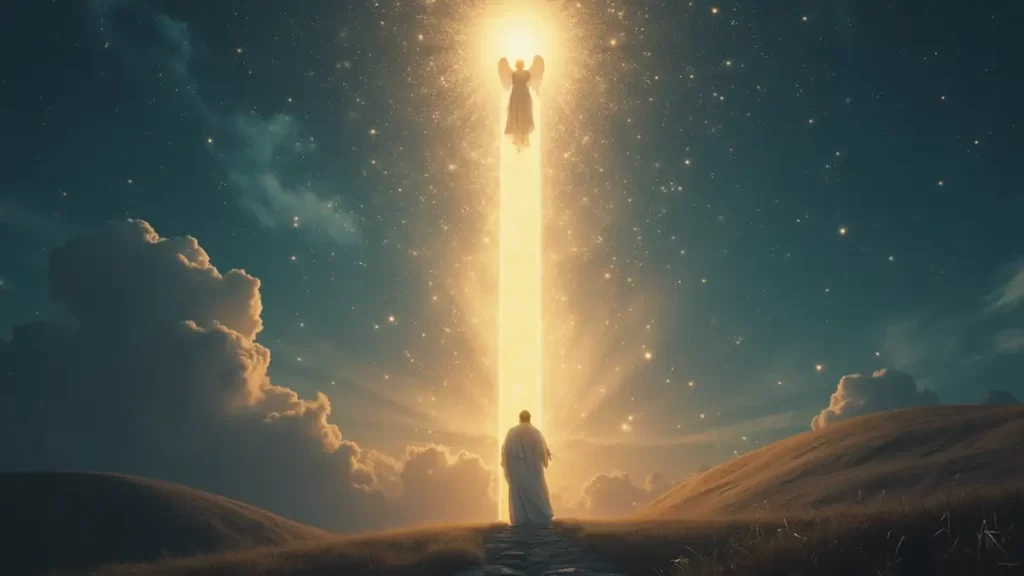

Imagine laying your head on a stone and drifting into a dream so vivid it feels like a doorway to another world. That’s what happened in Jacob’s Dream of the Ladder.
In this powerful vision, Jacob saw a ladder stretching from the earth to the heavens, with angels moving up and down. And at the top, God Himself stood, reaffirming the covenant He had made with Abraham.
This wasn’t just any dream—it was a divine message, deeply connected to biblical dream interpretation and the promises that God made to Abraham.
Before this remarkable vision, Jacob was on a journey of his own. He was fleeing from his brother Esau, heading to his uncle Laban’s house. Life was uncertain, and the future seemed unclear.
But as Jacob traveled, he carried with him the weight of a promise—a covenant made by God with Abraham. This covenant promised that through Abraham’s descendants, all the nations of the earth would be blessed.
That night, as Jacob lay under the stars, he couldn’t have known that God’s covenant with Abraham would be reaffirmed in a way that would change his life forever.
This is where biblical dream interpretation plays a crucial role in understanding the depth of Jacob’s Dream of the Ladder.
As Jacob slept, he dreamed of a ladder, or stairway, reaching from the earth all the way to heaven.
Angels were ascending and descending on it, moving between the two realms.
At the top of the ladder stood God, who spoke directly to Jacob: “I am the Lord, the God of Abraham your father and the God of Isaac; the land on which you lie I will give to you and to your offspring” (Genesis 28:13).
This vision wasn’t just about a ladder—it was about the connection between heaven and earth, and how Jacob’s Dream of the Ladder was a key moment in the unfolding of God’s covenant with Abraham. Through biblical dream interpretation, we see that this ladder symbolizes the ongoing relationship between God and humanity, bridged by divine promise.

In Jacob’s Dream of the Ladder, God didn’t just appear to Jacob—He reiterated the covenant that had been the foundation of Jacob’s family’s faith for generations.
God’s promise to Abraham was now being passed directly to Jacob. The land, the blessings, and the promise that all nations would be blessed through his offspring were now his to carry forward.
This reaffirmation was a turning point for Jacob. The dream wasn’t just a vision; it was a divine assurance that God’s covenant with Abraham was still in place, and that it would be fulfilled through Jacob and his descendants.
This moment highlights the importance of biblical dream interpretation in understanding God’s messages.
Catholic Interpretation:
In Catholic tradition, Jacob’s Dream of the Ladder is seen as a symbol of the connection between heaven and earth. The ladder represents Jesus Christ, the mediator between God and humanity, through whom the promises of the covenant are fulfilled.
The dream is also seen as a foreshadowing of the Church, which connects believers with the divine.
Protestant Interpretation:
Protestant interpretations often focus on the personal nature of Jacob’s encounter with God. The dream is viewed as a moment of grace, where God personally assures Jacob of His presence and promises.
The ladder symbolizes God’s ongoing interaction with the world, and the angels represent His messengers, carrying out His will.
Both interpretations emphasize the significance of Jacob’s Dream of the Ladder in the broader context of God’s covenant with Abraham and biblical dream interpretation.
Jacob’s Dream of the Ladder has had a profound impact on religious thought and art throughout history. It has been depicted in countless paintings, sermons, and theological discussions, symbolizing the connection between the divine and the earthly.
Even today, believers find inspiration in Jacob’s dream, seeing it as a reminder that God’s covenant with Abraham is ever-present, guiding us even when the path ahead seems uncertain.
This is where biblical dream interpretation continues to offer insights into how dreams can reflect divine truths.
Jacob’s Dream of the Ladder was more than just a vision—it was a powerful reaffirmation of God’s covenant with Abraham. Through this dream, Jacob was reminded of God’s promises, which continue to echo through the generations.
This story encourages us to trust in divine connections, knowing that, just like Jacob, we are part of a greater story. Biblical dream interpretation shows us how dreams can bridge the gap between heaven and earth, revealing the ongoing relationship between God and humanity.